Visiting Indigenous Tribes Of The Lacandon Deep In The Jungles Of Chiapas Mexico
Tonight I was asked to speak to a group of 60 people who were gathered to learn about permaculture at the 21 Acres Center, a non-profit organization and a leader in sustainable and regenerative practices, serving as a living laboratory center for conscious consumers who want to learn new, more sustainable ways of living.
There were three other people who spoke about various sustainable farming practices and I closed the meeting with a talk about food forests.
A food forest is a topic I'm very passionate about and I think the talk went well based on the reactions of the group. I made some good connections networking with everyone and people offered to volunteer to help work on the current project I'm installing. You can never have too much help that's for sure.
One of the reasons I'm building another food forest is it occurs to me that for all the talk about growing food forests and the growing popularity of permaculture, there are far too few living examples of real food forests in the United States.
I have visited many so called food forest across the US and most of them resemble a collection of gardening projects that someone read in a book or online.
I'm building a food forest so people can see what it really is, a living ecosystem that self-replicates and self-regulates. It's beyond sustainable, it's thriving, unstoppable and also produces food. I'm amazed how few examples there are in this country.
A food forest defined by Wikipedia is:
Forest gardening is a low-maintenance sustainable plant-based food production and agroforestry system based on woodland ecosystems, incorporating fruit and nut trees, shrubs, herbs, vines and perennial vegetables which have yields directly useful to humans. Credit
That definition is close, but not quite. It's misleading to say that it's plant-based, for one example, as animals play an important role in a forest ecosystem.
Building a food forest takes years to accomplish and the design is very site specific. Our modern society doesn't think long-term enough to even grasp the concepts and that's one of the reasons there are so few examples.
One of the most amazing examples of a food forest I have ever seen was in Chiapas, Mexico.
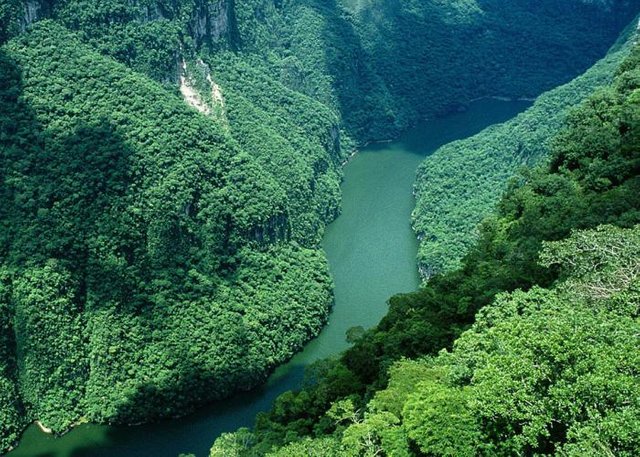
I was staying in a hostel in San Cristobal De Las Casa that was once the home of Gertrude Blom, a Swiss journalist, social anthropologist, and documentary photographer who spent five decades chronicling the Mayan cultures of Chiapas, Mexico, particularly the culture of the Lacandon Maya.
The Lacandon are the oldest, living indigenous tribes in Mexico and escaped the Spanish colonialism of the Mexican population by living deeper in the jungles than the conquistadors ventured.
The hostel where I was staying had photographs of her work with the local Lacandon tribes hanging on the walls and I became fascinated by the images of these indigenous people, still living in the forests as their ancestors had for centuries. I made a decision to travel to the jungle in search of their settlements and to get to know them and their ways.
My friends warned me not to go. "It's a jungle out there.", they said.
Having just retired from the music business and taking a year off to decide what to do with the rest of my life, my original plan was for a three month vacation that magically turned into a year of traveling around Mexico. A three week jungle boogie sounded like my kind of adventure.
So I took my friends concerned advice and gave it right back to them. "I'll be fine. Don't worry.", I told them. (Famous last words)
Discovering that the Lacandon don't speak Spanish, but rather their own language, I hired an interpreter-slash-tour guide, to get me there. He assured me that he knew the way there and spoke their language fluently.
The Lacandon speak a Mayan language closely related to Yucatec Maya. In their own language they call themselves Hach Winik ("Real People", ʜatʃʰ ʋinikʰ) and they call their language Hach T'ana ("Real Language"). Credit
Not wanting to show up empty handed, I bought some supplies to bring with me to give as gifts to the local tribes people.
- 100 pounds of rice
- 100 pounds of beans
- 50 ponds of salt
- 20 Bic lighters
- 2 cartons of cigarettes
- 2 dozen fish hooks
- knives
- knife sharpeners
- 4 bottles of tequila
- a roll of cotton cloth
- a few blankets
- candy and chewing gum
- and a few other things that could prove useful
We rented horses, one for the guide and two for me. One for the supplies I brought and another for me to ride.
I'm good on a horse and have traveled on some very rugged, steep terrain for up to 100 miles before. Nothing prepared me for this horse trip though.
First off, the horse was so small that it felt like I should be carrying it. I felt bad getting on this poor, tiny creature, but the horse, it turns out, did just fine.
What I wasn't prepared for was the solid, wooden saddle. No padding or cushion, just a saddle carved out of a solid piece of wood. A day and a half of riding had my butt sore as hell by the end of the ride.
That night as we made camp by the Usumacinta River, I soaked by tired gluts and cracked open the first bottle of tequila and the next day was a painful trek through some seriously, thick jungle.
We made the additional half day ride the following day and paid a village farmer to board our horses until we returned three weeks later.
The next morning, we broke camp, had a good breakfast of eggs and bacon and some of the best coffee I have ever tasted, packed our rented canoe with all our supplies and paddled all day long though the jungle and up the river.
Monkeys, toucans, flamingos and other various jungle fowl sang exotic choruses along the river banks to the rhythm of our paddles cutting through the water, transporting me to a time of perfect awareness.
Far from any signs of civilization, one feels enveloped in genuine living, as if everything one knew before this moment was only a dream and the only reality that exists is now.
My guide, Pepe, seemed confident of our whereabouts and I knew from experience that guardian angels were looking over me, but as I heard the roar of a waterfall quickly approaching, I stole a nervous glance in his direction and before I could become alarmed, he gestured for us to shore up to the rivers edge some distance ahead.
Just as our canoe sliced into the soft sand of the shore, a man on another canoe, appearing from nowhere, pulling up behind us. He slowed down next to us, still in the river's current, but staying in one place alongside us. His canoe was somehow hovering, seemingly effortlessly, in the middle of the fast current without being swept away by it. It appeared to defy logic and gave him an aura of having magical powers.
He spoke in a sound I had never heard before. It was a human sound interspersed with clicking noises that reminded me of the sound of someone smacking their lips. I couldn't decipher a single word, but somehow understood his body language expressing his only concern. He was warning us of the fast approaching waterfall looming ahead.
I looked to Pepe for some help communicating, but he looked distracted with unloading our supplies, so I played charades with the floating magician and he made a gesture with two fingers walking as he pointed into the forest.
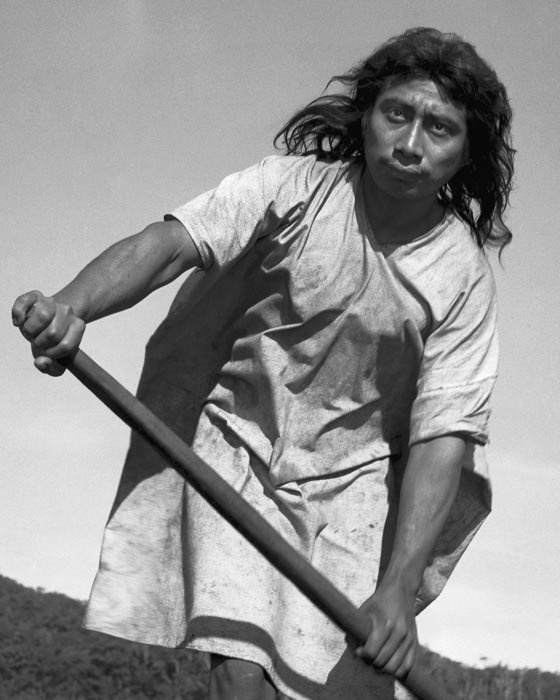
We all disembarked our canoes and as the man helped us unload our supplies, it became clear he wanted us to follow him through the jungle. Just as I was calculating how many trips it would take to get all our stuff to where ever it was we were going, more people showed up to help us carry everything.
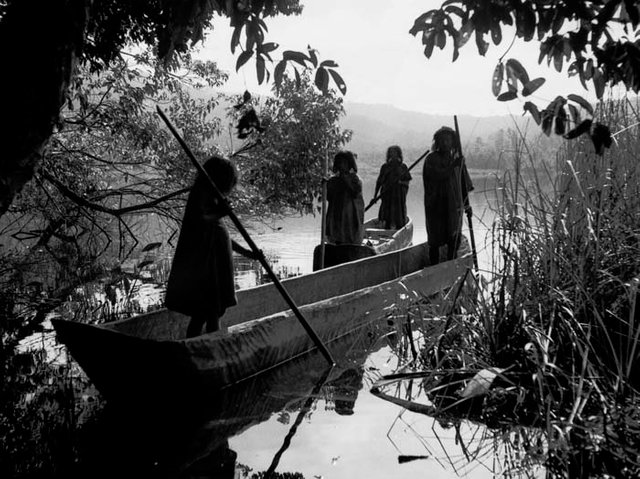
We walked a short distance through the jungle as mosquitoes devoured every exposed patch of skin they could find on me. The man motioned for me to stop and he pulled some leaves off a shrub and rubbed them on my skin which repelled the mosquitoes.
We arrived to a small compound of grass huts and were greeted by everyone in the village of about 100 people.
I met with what appeared to be the village elder and called Pepe over to interpret for me that I had gifts I would like to give to him and his village. It soon became apparent that Pepe had no idea what the man was saying so I played a little game of charades until he understood that I wanted to share with his village what I had brought with me.
He uttered a sound and the whole village gathered around us. The entire village divided the rice and beans among themselves equally without making a single sound. They looked like an ant colony the way they systematically partitioned the supplies with a calm, steady pace of cooperation.
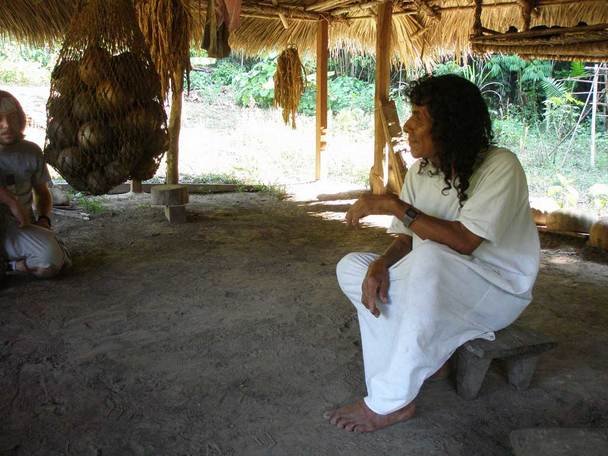
The "chief" was particularly interested in the fish hooks and Bic lighters I had given him and those, he kept for himself.
They showed me to a hut and I somehow understood it was to be our quarters so we unpacked as children watched us with fascination. I set up a tent and the nylon fabric it was made of was of particular interest to the children, who apparently never saw anything like a tent before.
For three weeks we made this our home and during the whole time of our stay, each person in the village brought us gifts of food the likes of which I have never seen. Honeyed beetles, monkey meat and some type of garlic tasting root that was absolutely delicious.
Once we were settled, the men approached us with a small set of bow and arrows and invited us to go hunting. I couldn't hit a damn thing to the amusement of all the men. They on the other hand were expert marksmen and provided all the food we could eat for our entire stay.
I tried my best to ask them where their farm was but received only blank stares each time I inquired, but as I watched them bring food into the village I decided to follow them to see where they were going to get all of this bounty each day.
I soon realized that the "farm" was all around us. There was food growing in every nook and cranny of the forest floor, the branches of trees, the vines and roots and the river. The entire forest was edible and useful in some way to these people.
For a people, to the casual observer, who had nothing, they were the most generous, gentle and kind people one could ever encounter. My initial feelings of pity for these poor, jungle peasants soon turned to pity for us modern "civilized" people. Though they had none of the trappings of our world, they possessed a freedom and knowing of their place in the "real world" few of us could ever understand.
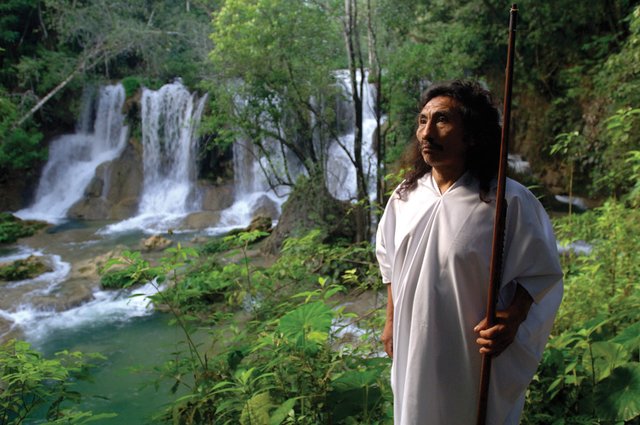
They treated each other with kindness and dignity we would be wise to emulate and helped one another without a thought of repayment of any kind. It was just what a "real human" did and no personal gain was implied or expected from their generosity.
Feeling I needed to repay them for their kindness, I started helping in any way I could, but came to understand that the work load was clearly divided between the men and women. The women gathered and prepared food, owned the house and made all decisions concerning the children and household, while the men constructed things, made tools and hunted.
From drawing pictures in the sand, the chief explained to me that they were going to fell a tree, an act they don't take lightly. They needed another canoe for a new family who borrowed any available canoe not being used until it wasn't possible to use the loaned canoe any further due to the size of the village expanding. Only when the village absolutely needed to, would they build another canoe.
Before deciding to cut the tree down, they would gather around the chosen tree, have a ceremony each full moon for an entire year, asking permission to the tree to grant them this gift of its wood, explaining their need for it and only cutting it after they were sure the tree was in agreement. We arrived a few days before they were to cut the tree down and so I helped with the task.
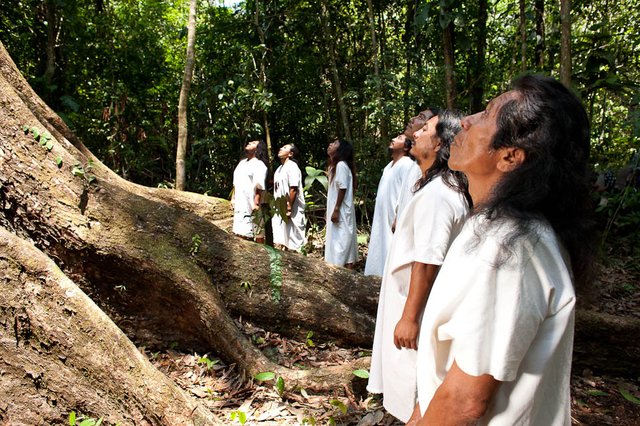
Over the next three weeks I watched as they carved the solid mahogany tree into a new canoe. They began by painting the tree with a pine-like sap from another tree and setting it on fire. They would dowse the fire with water and easily carve the soft charcoal that remained. They repeated this process for weeks until a canoe was carved out of a solid trunk of a tree.
The last thing they do before the canoe is finished is have a ceremony to teach the canoe to float. We carried it to the water and would carve the final bits and pieces until the canoe was perfectly balanced. Once it was, we had a whole day of festivities as the new family received their canoe. Even though it was officially theirs, anyone could use it if it was not being used at the time. That's just how they roll.
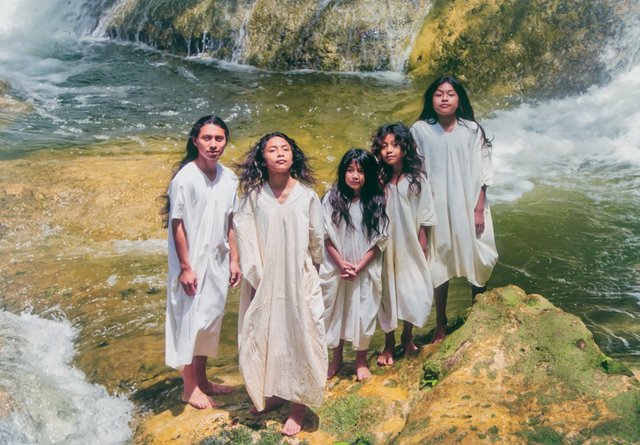
The Lacondon do not like to be photographed, as they believe that when a picture is taken of someone they lose a piece of their soul. Out of respect, I never took a single picture while I was there.
When it was finally time for us to leave, they gave me a bow and some arrows to take with me so I could learn how to hunt and provide for others.
I'll never forget the experience and the kindness they showed me, this stranger from another world, and every time I'm in the woods away from civilization, my memories return to this time and place that I shared with these people and I feel in the core of my being like a real human.

Wow @luzcypher - my admiration for you and your work just grew tenfold!
I am so excited to learn more about food forests and your projects. What wonderful work!
It's a labor of love. Plus you get food.
Thank you for your incredible sharing of the profound experiences you had on your journey! I feel my soul has expanded and my love for the connection to the earth and its people has deepened as well.....Wow, I have also been to Chiapas a few years ago but I had not heard of this tribe. So sweet.
There are so many interesting tribes in Chiapas. The Lacandon are the most remote and the oldest tribe. They also are the only tribe that grow food forests with 20 year crop rotations. Every other tribe slash and burns the forest, depleting it in about 3 years then moving on to another slash and burn crop.
It was amazing to see a forest supply food for 100 people. All they had to do was harvest it.
this is the consciousness I want to be a part of, thank you so much for your inquisitiveness and your passionate soul, In Lak'ech! ps I love your name catchy,...the cypher of light. Depth anyway you read it! Happy to be part of your tribe my friend.
Trees are so under-appreciated. There is so much potential for increasing local food productivity with trees, so much. I eat a lot of tree leaves, flowers, seeds, and fruits - depending on the time of year and kind of tree. There's more to a forest than trees, of course, but they give so much and ask for so little.
Trees provide so much more that people realize.
Wonderful post and environmentally friendly. Your adventures have granted you lifelong experiences and wisdom. Offering peaceful gifts to the local tribes is a commendable act of appreciation as well. Upvoted thanks for sharing
Thanks for reading and upvoting
Great post! Thank you.
Fantastic story. Thanks for sharing!
Wow, never heard of this before? , Thank You.